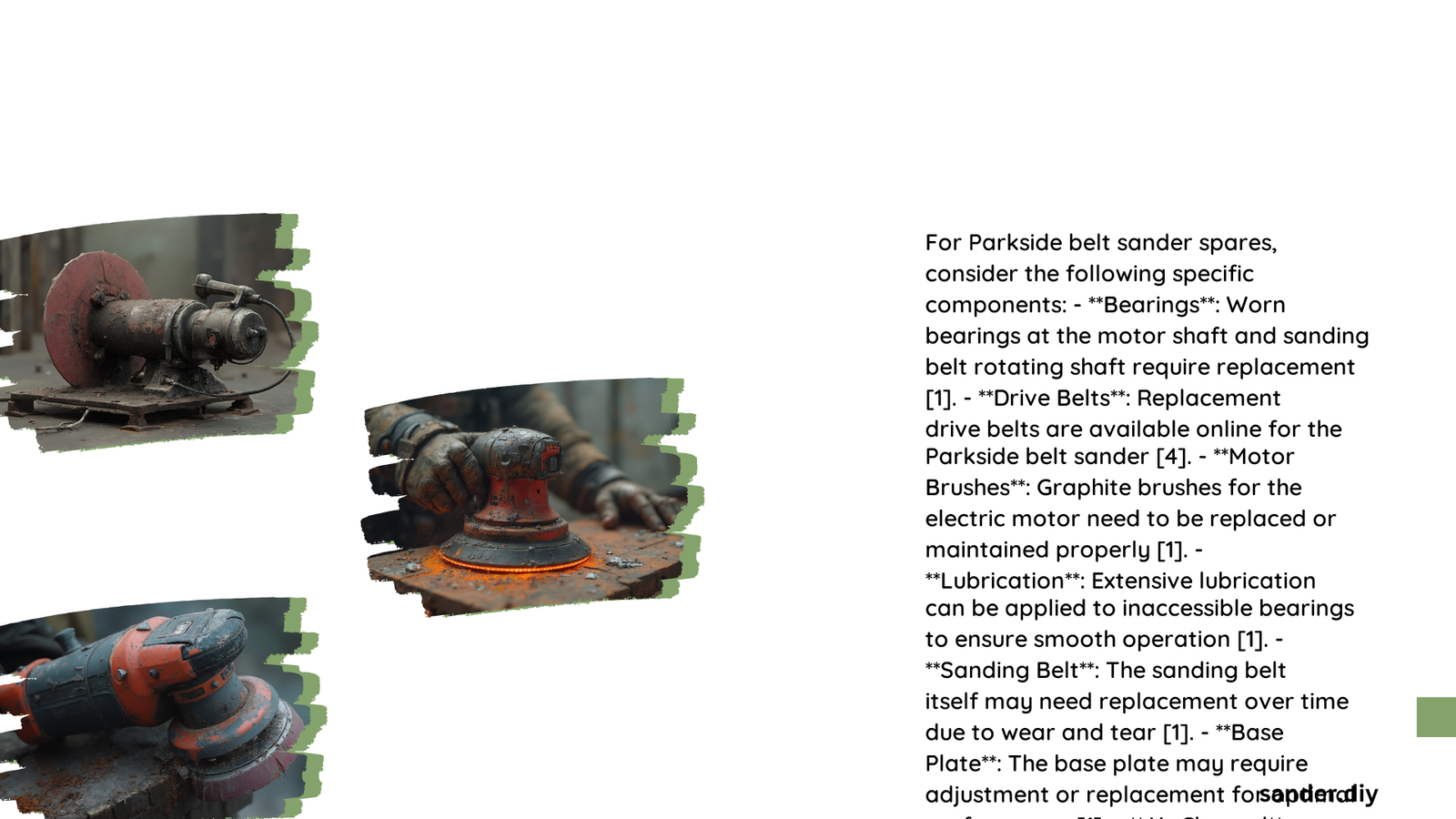Parkside belt sander spares are crucial components for maintaining and repairing these popular power tools. From sanding belts to motor parts and roller wheels, understanding the various spares available is essential for DIY enthusiasts and professionals alike. This comprehensive guide covers the types of spares, their specifications, and how to source them effectively.
What Are the Essential Parkside Belt Sander Spares?
Parkside belt sander spares encompass a wide range of components, each playing a vital role in the tool’s functionality. Here’s a breakdown of the key spares:
- Sanding Belts
- Motor Components
- Roller Wheels
1. Sanding Belts
Sanding belts are the most frequently replaced spare part for Parkside belt sanders. They come in various specifications:
- Compatibility: Available for models like Parkside PBS600A1 and Bosch PBS7A
- Material: Typically made from abrasive materials such as silicon carbide or aluminum oxide
- Grit Sizes: Range from coarse (e.g., 80 grit) to fine (e.g., 120 grit)
| Grit Type | Grit Range | Typical Use |
|---|---|---|
| Coarse | 40-60 | Heavy material removal |
| Medium | 80-120 | General sanding |
| Fine | 150-180 | Finishing work |
2. Motor Components
Motor components are crucial for the sander’s operation and may need replacement over time:
- Start-up Relay: Essential for models like Scheppach BTS900X, BTS800, and Kity PBD900
- Capacitor: Specific types like 100UF – 250V are available for start-up machines
3. Roller Wheels
Roller wheels are integral to the belt sander’s mechanism:
- Drive Roller: Compatible with various models including Scheppach BTS900X
- Drive Roller Rod: Ensures smooth operation of the sanding belt
How Do Sanding Belt Specifications Vary?

Sanding belts for Parkside belt sanders come in various specifications to suit different tasks:
- Grit Sizes: Range from coarse (40-60 grit) to fine (150-180 grit)
- Dimensions: Vary by model, designed to fit specific belt sander specifications
- Material: Typically silicon carbide or aluminum oxide for durability
What Are the Common Motor Repair Challenges?
Repairing a Parkside belt sander motor can be challenging. Here are some key points to consider:
- Necessary Tools:
- Screwdrivers
- Pliers and wrenches
-
Multimeter for electrical diagnostics
-
Typical Failure Points:
- Start-up relay
- Capacitor
-
Motor windings
-
Estimated Costs:
- Parts: £10 to £50 for components like relays or capacitors
- Labor: £20 to £100+ for professional repairs
What Are the Key Specifications for Roller Wheels?
Roller wheels are crucial for the smooth operation of Parkside belt sanders:
- Diameter: Varies by model, designed to fit specific sander specifications
- Material: Usually rubber or metal for durability
- Replacement Frequency: Typically every few months to a year, depending on usage
How to Source Parkside Belt Sander Spares?
Sourcing the right spares is crucial for maintaining your Parkside belt sander:
- Recommended Suppliers:
- Probois Machinoutils
-
Solent Tools
-
Pricing Considerations:
- Sanding Belts: £5 to £20 per pack
- Motor Components: £10 to £50
-
Roller Wheels: £10 to £50
-
Compatibility Check:
- Always verify part compatibility with your specific Parkside model
- Consider OEM parts for optimal performance
What Maintenance Tips Can Extend the Life of Parkside Belt Sander Spares?
Proper maintenance can significantly extend the life of your Parkside belt sander spares:
- Regular Cleaning:
- Remove dust and debris after each use
-
Use compressed air to clean hard-to-reach areas
-
Proper Storage:
- Store in a dry, cool place to prevent moisture damage
-
Use a dust cover when not in use
-
Timely Replacements:
- Replace sanding belts when worn
- Check motor components annually
- Inspect roller wheels for signs of wear
How to Troubleshoot Common Parkside Belt Sander Issues?
Identifying and resolving issues early can prevent the need for extensive repairs:
- Belt Tracking Problems:
- Adjust the tracking mechanism
-
Check for worn roller wheels
-
Motor Overheating:
- Clean ventilation slots
-
Check for worn brushes
-
Unusual Noises:
- Inspect bearings and rollers
- Tighten any loose components
By understanding these aspects of Parkside belt sander spares, you can maintain your tool effectively, ensuring its longevity and optimal performance.
References:
1. Parkside Belt and Disc Sander Parts – Probois Machinoutils
2. Parkside – Spare Parts – Solent Tools
3. Spare parts for Parkside machines – Probois Machinoutils
